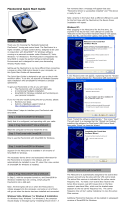
enclosure.
For digital mode support see the following link for a modified diagram: Digital Mode
Diagram. If using the digital setup, care should be taken to setup the second sound card
mixer correctly. Make sure that the Line In Mute on the Playback mixer is muted.
Here is a functional description of each input and output from the Delta 44 break out box:
Out 1 & 2: -10dBV nominal stereo speaker/headphone output. This will normally be
connected directly to either powered speakers or headphones. It will work also with un
powered speakers but don't expect -10dBV to blow the doors off. We use headphones on
this output with no problem. Windows sounds will play through this output if you have the
Delta 44 set as the default sound card in the Windows Control Panel. You will need either
a stereo coupler (barrel) or "Y" connector for this connection.
Out 3 & 4: This is -
10dBV I and Q modulated audio going to the transmitter, which must be
connected to the jack on the radio marked, "To Line Out." Failure to seat this connector
properly will cause transmission of double sideband signals. Note that the speaker jack on
the back of the radio is in parallel with the transmitter I & Q signals through a mute relay.
This "SPKR" jack on the radio is ONLY to be used for consumer audio cards that do not
have the number of outputs supplied by the Delta 44. It should NOT be used with the Delta
44.
In 1 & 2: This is +4dBU level I and Q from the down converted baseband receiver audio.
This cable must be connected to the jack marked, "To Line In." Failure to fully seat this
connector will cause loss of image rejection on the receiver.
In 3: This is the -10dBV nominal microphone/digital mode input port. For normal operation
it should be connected to the jack on the back of the radio which is just ABOVE the words,
"To Mic In." The jack is a DIRECT connection to the front panel 4-pin microphone
connector. The wiring table can be seen in the Operating Manual in Chapter 3: Pinouts.
We have used this with a Heil Pro series microphone with success. If preferred, you can
connect the microphone directly to In 3, bypassing the front panel connector.
In 4: This channel is not used. If using Hosa cables with dual 1/4" plugs, make sure to
terminate this channel with the orange plug.
Step 4: Download the drivers
Now that you have the sound card hardware installed, it is time to help the operating
system understand how to talk to it. Use the following link to get to the driver download
page on the M-Audio website: Link Optionally fill out the requested info (not necessary)
and then click on the link in the yellow box to download the driver. Once downloaded, run
the file to install the drivers. It may be necessary to reboot after the installation is
file://\\Server\flexradio\Website\WWW\delta44\delta44.htm















